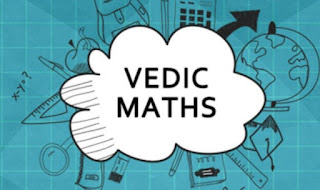VEDIC MATHS-57
VEDIC MATHS
By OMKAR TENDOLKAR
Hello friends,
This is post number 57 from the series of "Vedic maths" blogs. Here in this blog we will learn about "Application of vinculum Square and cube"
The technique of vinculum is very powerful and provides us with a method to convert digits in a number which are greater than 5, to digits less than 5.
After the conversion, all arithmetic operations are carried out using the converted number, which make the operation very simple and fast.
It is not necessary to convert all the digits but a judicious conversion of certain digits (above 5) can decrease the computation effort considerably.
VINCULUM NUMBER:
The numbers which by presentation contains both positive and negative digits are called vinculum numbers.
We will begin by seeing the method to convert any given number to its vinculum equivalent and back to its original value.
You may ask your any query or doubt in comment box. I will try to resolve as early as possible.
Reference:
We had already learn about "Concept of vinculum number & Conversion of general numbers into vinculum numbers" in our previous blog. If you have missed my last blog then please visit "VEDIC MATHS-53".
We had already learn about "Concept of vinculum number & Conversion of vinculum numbers into general numbers" in our previous blog. If you have missed my last blog then please visit "VEDIC MATHS-54".
We had already learn about "Application of vinculum addition and subtraction" in our previous blog. If you have missed my last blog then please visit "VEDIC MATHS-55".
We had already learn about "Application of vinculum multiplication and division" in our previous blog. If you have missed my last blog then please visit "VEDIC MATHS-56".
a) Application of vinculum Square :
In order to get the square of any number, we need to compute duplex values of a lot of numbers. If some of the digits are above 5, the computation of the duplex becomes tedious. Consider the square of 897. The computation of the duplex is quite time-consuming since the digits are big. We will see the magic of the Vinculum digits now.
The computation can be simplified further if we convert the non-vinculum digits to vinculum digits. We will see the method below.
_
897 = 9 0 3
_ _
= 1 1 0 3
Both are valid vinculum equivalent numbers.
We will now compare the computation of the square of the given number for all these numbers.
(897)^2 = 64 / 144 / 193 / 126 / 49 = 804609
_ _ _ _ _
(903)^2 = 81 / 0 / 5 4 / 0 / 9 = 815409 = 804609
_ _
Let's look at the next conversion, i.e. (1103)^2
_ _ _ _ _
(1103) = 1 / 2 / 1 / 6 / 6 / 0 / 9 = 816609 =804609 as before.
We can see that the computations become increasingly simpler.
b) Application of vinculum cube :
Consider the cube of 89 where (89)^3 = 704969
The computation without using the vinculum would appear as follows :
(89)^3 = 512 | 576 | 648 | 729
| 1152 | 1296 |
----------------------------------
704 | 9 | 6 | 9
The computation is very tedious and cumbersome.
Let’s convert to vinculum and see what is the result.
_
89 = 91
_ _ _
91 = 729 | 81 | 9 | 1
_ _ _
| 162 | 18 |
------------------------------
_ _ _ _
729 | 243 | 27 | 1
_ _
= 706 | 1 | 7 | 1
= 704969
This is easier and faster
In each of the operations it can be seen that the operation on the corresponding vinculum number is both easy and fast. The reader has to practice to convert numbers to their vinculum equivalents and back again, to fully avail of the power of this technique.
Solve the following example.
- (779)^2 = 606841
- (47.8)^2 = 2284.84
- (29)^3 = 24389
The simplicity of this method can be vouched from examples given above.
You may try following example:
1. (879)^2
2. (38)^3
3. (19)^3
You may answer this in comment box. You may ask your any query or doubt in comment box. I will try to resolve as early as possible.
In next blog we will discuss about "Duplex method".
Are you excited for this?...
Then, please wait for it.
I will post my new blog in next week.
We will meet very soon through our next blog. Till that stay connected, stay healthy and stay safe.
Thanks
for giving your valuable time.
Good day😊..


Comments
Post a Comment